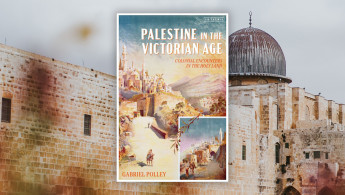Colonialism, evangelism and the Zionist project: What was life in Palestine like during the Victorian age?
Various dates are associated with the colonisation of Palestine, notably 1917 which ties into the Balfour Declaration, and 1948, the year of the Nakba.
Gabriel Polley’s new book, Palestine in the Victorian Age: Colonial Encounters in the Holy Land (I.B. Tauris, 2022) sets the scene earlier, with the Victorian era travellers to Palestine when it was under Ottoman rule in the 19th century.
“Like all European ‘explorers’, these travellers discovered regions already inhabited by an indigenous population who knew their homeland intimately,” Polley writes.
However, as the book illustrates through drawing upon lesser-known writings on the subject, early narratives on Palestine adopt the language of alleged discovery as other European travellers, thus alluding to external domination over the indigenous even before the entrenchment of the Zionist settler-colonial project.
"Throughout the book, the hospitality of the Palestinians is noted and juxtaposed against the Orientalist perspectives of the non-Jewish European travellers to Palestine; the latter playing an influential role in shaping the colonial aspirations of Zionism"
The book depicts how the travels of European Evangelicals and Protestants gave rise to a genre of Holy Land literature and travel narratives which was accessible mostly to affluent Victorians.
As Britain became aligned with the Restoration, Biblical belief and imperialist domination merged, resulting in the aim to gradually reconquer Palestine through the so-called “Peaceful Crusade” which focused on religious, cultural, missionary and philanthropical activity.
Not only diplomatic, the Peaceful Crusade was largely also a Victorian traveller’s domain. A diary entry by Irish traveller Eliot Warburton partially reads, “This Holy Land, although no longer an object of bloody ambition, has lost none of the deep interest with which it once inspired the most vehement crusader … Narrow as are its boundaries, we have all a share in its possession: what a church is to a city, Palestine is to a world.”
|
Through an analysis of the Victorian travel narratives and anecdotes, Polley notes the dehumanisation of the indigenous Palestinian people and the inability of European travellers to converse in Arabic with the locals.
Throughout the book, the hospitality of the Palestinians is noted and juxtaposed against the Orientalist perspectives of the non-Jewish European travellers to Palestine; the latter playing an influential role in shaping the colonial aspirations of Zionism.
The Evangelicals’ concern with Palestine, Polley notes, lay largely in Biblical archaeology, thus the indigenous communities were of no concern to the travellers. “Western travellers applied to Palestine a claim which had been articulated by supporters of settler-colonialism since the seventeenth century … that moral ownership of land lay not with its indigenous custodians who resided there before Western imperialism turned its attention on their territory, but rather with whoever could make the most economically productive use of it.”
Zionism and its proponents made similar statements about rescuing the land from the indigenous through superior farming techniques, neglecting the fact that Palestine’s arable land was sustainably farmed before the settler colonies embarked on their land theft.
While at times objective observations were made by European travellers, the colonial mind frame was still an influence, as in the case of US traveller Edmund Robinson who lauded settler-colonialism in the US but expressed no interest in Zionism.
Charles Warren and Claude Coder, on the contrary, were considered inspirational to the Zionist movement. Members of the Palestine Exploration Fund (PEF), both were favourable to the idea of colonising Palestine by the British and, or, Jewish settlers.
Warren is considered to have envisaged what would happen in the aftermath of the Balfour Declaration and the British rule in terms of European settler-colonialism in Palestine. However, while Victorian travellers imagined a submissive indigenous population, Palestinians proved otherwise through their anti-colonial struggle.
|
Polley’s discussion of James and Elizabeth Finn’s settler-colonial enterprise sheds light on the later Zionist colonial settlements. As with later Zionist depictions of Palestine, the Finns inaccurately portrayed Palestine as uncultivated and used the description to advocate for settler-colonisation. “It was the inaccurate ideologically determined idea of Palestinians and underpopulated and underutilised which gave an impetus to the expectation of the coming triumph of settler-colonialism in Palestine.”
Additionally, the reconstruction of Palestinians in travellers’ narratives reaffirmed the Orientalist belief that non-Europeans were incapable of representing themselves.
The later Zionist erasure of Palestine is seen in James Finn’s approach to settler-colonialism. Jewish refugees from the Crimean War became “participants in a project with political implications,” Polley writes. The aim was to establish a larger Jewish agricultural enterprise in Palestine, complete with replacing place names from Arabic with Hebrew, thus falsely “indigenising” the settler-colonialists.
The colonial framework was also perceived in terms of European concepts of infrastructure in Palestine for the settler colonies, even as a turn towards the annihilation of the indigenous Palestinian population became a prominent feature among travellers.
The US annihilation of Native Americans provided a blueprint for the concept of what could happen in Palestine, as seen in ‘The Land of Gilead’ by Laurence Oliphant, which was published in 1880 and is described as containing the most feasible colonisation plan.
The colonies were described by Oliphant as villages, thus naturalising the settler in Palestine. Settler superiority was also asserted in envisaging a time when settler-colonialism in Palestine could proceed without relying on indigenous labour.
Besides tackling a specialised subject that adds historical context, Polley’s research on Victorian-era travels in Palestine presents an opportunity for the reader to link the historical trajectories of colonialism to the present.
Ramona Wadi is an independent researcher, freelance journalist, book reviewer and blogger specialising in the struggle for memory in Chile and Palestine, colonial violence and the manipulation of international law.
Follow her on Twitter: @walzerscent



